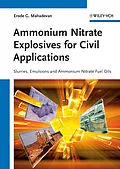The book describes the science and technology of formulation and manufacturing of non-nitroglycerine explosives with ammonium nitrate as the main ingredient. Based on the author's industry experience of more than thirty years, it provides an unparalleled treatment of one of the commercially most important classes of explosives and therefore stimulates further research and development efforts in the field of explosives for civil applications.
Autorentext
Erode Mahadevan is currently a Technology Consultant based in India. Before that for more than thirty years he was engaged in the field of commercial explosives and accessories and specialty chemicals. He has worked with many multinational companies such as ICI (UK), BASF (Germany), Atlas Chemicals (USA), Dow Chemical (USA), Nitro Nobel (Sweden), Dyno Industries (Norway). For twenty years Erode Mahadevan was Managing Director of IDL Industries Ltd., a leading producer of civil explosives based in India. He holds a Masters Degree in Physical Chemistry from the University of Mysore, Bangalore, and a PhD from the Technische Hochschule in Karlsruhe, Germany. Before starting his career in industry, Erode Mahadevan was a postdoctoral researcher at the Department of Chemistry at the Columbia University, New York.
Inhalt
Acknowledgment XI
Preface XIII
1 Classification of Explosives 1
1.1 Initiation Sensitivity 1
1.2 Size 1
1.3 Usage 2
1.4 Physical Form 2
2 Explosive Science 5
2.1 Introduction 5
2.1.1 Low Explosives 5
2.1.2 High Explosives 5
2.2 Initiation and Detonation 6
2.2.1 Mechanism 6
2.3 Propagation and Detonation 7
2.3.1 Propagation 7
2.3.2 Detonation 8
2.3.2.1 Ideal/Nonideal Detonation/Critical Diameter/Ideal Diameter 9
2.3.2.2 Detonation Pressure and Velocity 9
2.4 Reaction Chemistry in Explosives 11
2.4.1 Heat of Reaction 11
2.4.2 Rules of Hierarchy 12
2.4.3 Calculation of Oxygen Balance and Fuel Values 12
References 13
3 Ammonium Nitrate Explosives 15
3.1 Introduction 15
3.1.1 Chronology 15
3.2 Design of Commercial Explosives 16
3.2.1 Importance of Oxygen Balance 16
3.2.2 Physical, Performance, and Safety Requirements 17
3.3 Tests 17
3.3.1 Ballistic Mortar Test 18
3.3.2 Trauzl Lead Block Test 19
3.3.3 Velocity of Detonation (VOD) 20
3.3.4 Gap Test and Continuity of Detonation Test 22
3.3.5 Aquarium Test 23
3.3.6 Double Pipe Test 23
3.3.7 Cylinder Test (Crushing Strength) 24
3.3.8 Plate Dent Test 24
3.3.9 Underwater Test (UWT) 24
3.3.10 Crater Test 26
3.4 Assessment of Safety and Stability Characteristics 27
3.4.1 Impact Test 27
3.4.2 Torpedo Friction Test 27
3.4.3 Accelerated Hot Storage (ageing Test) 27
3.4.4 Cold Temperature Storage Test 28
3.4.5 Thermal Stability Tests Using DTA and TGA Procedures 28
3.5 Summary 29
References 29
4 Ammonium Nitrate and AN/FO 31
4.1 Introduction and History 31
4.2 Physical and Chemical Properties of Ammonium Nitrate 32
4.2.1 Basic Data 32
4.2.2 Decomposition Chemistry of AN 32
4.2.3 Phase Transition in AN and its Importance in Explosives 33
4.3 Manufacture of Ammonium Nitrate 35
4.3.1 Prilled Ammonium Nitrate 36
4.4 Ammonium Nitrate Fuel Oil Explosives 39
4.4.1 Background 39
4.4.2 AN/FO Manufacture 39
4.4.2.1 Mixing Process and Equipment 39
4.4.2.2 Continuous Process 40
4.4.2.3 Bulk Delivery Systems 40
4.4.3 Properties of AN/FO 41
4.4.3.1 Physical 41
4.4.3.2 Oil Absorbency and Porosity/Bulk Density/Crushing Strength 41
4.4.3.3 Resistance to Effect of Temperature Cycling 44
4.4.4 Characteristics of ANFO 45
4.4.4.1 Density/Strength 45
4.4.4.2 Strength of the AN/FO Explosive 46
4.4.4.3 Energy Content of AN/FO 46
4.4.4.4 Velocity of Detonation and Effective Priming 47
4.4.4.5 Mechanism of Detonation Propagation in AN/FO 49
4.4.4.6 Influence of Fuel 50
4.4.4.7 Effect of Moisture/Wet Boreholes/Water-Resistant AN/FO 50
4.4.4.8 Water-Resistant AN/FO 52
4.4.4.9 Increasing the Energy of AN/FO and its Fume Characteristics 52
4.4.5 Safety Considerations in AN/FO 55
4.4.6 Summary AN/FO Explosives 56
4.4.7 Quality Checks 56
References 58
Further Reading 58
5 Slurries and Water Gels 59
5.1 Development 59
5.2 Design 59
5.2.1 Large-Diameter Packaged Product (Water Gels) 60
5.2.2 List of Ingredients 60
5.2.3 Small-Diameter, Cap-Sensitive Water Gels 60
5.2.4 Bulk Delivery Product 61
5.2.5 Basic Concepts of Formulation 61
5.2.5.1 Oxygen Balance 61
5.2.5.2 Thumb Rules for Design 62
5.2.5.3 Role of Water 63
5.2.5.4 Basic Composition and Process 65
5.3 Process T...
